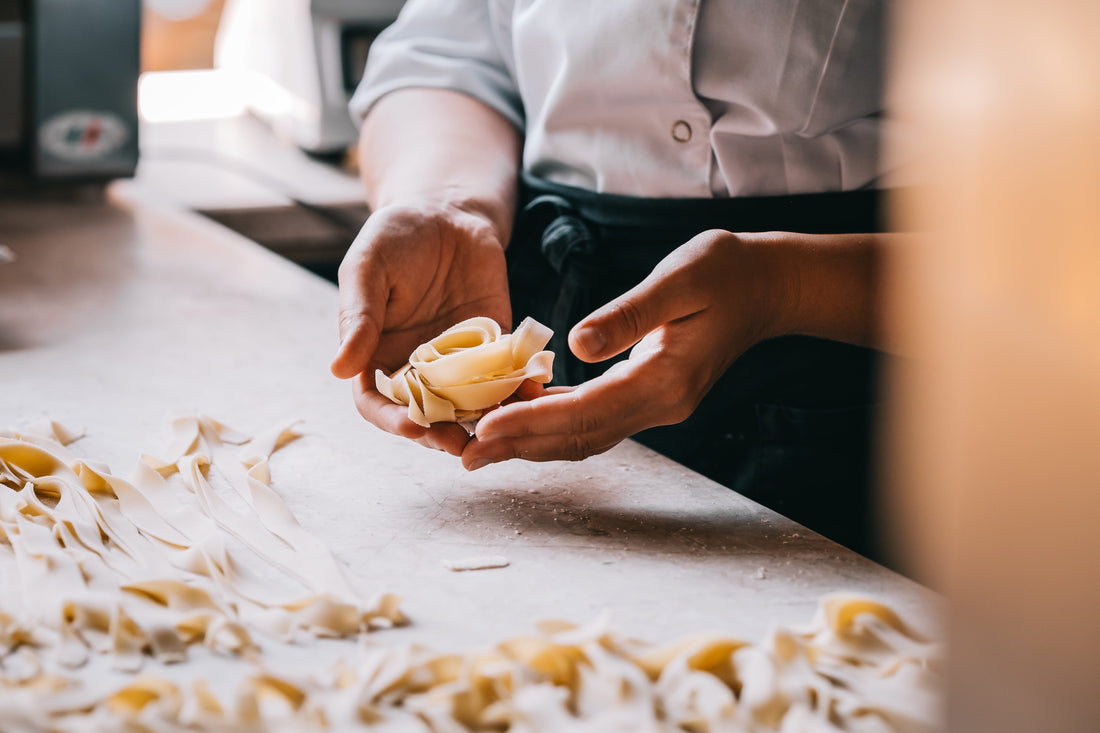
How to Make Fresh Pasta: Steps, Equipment and Practical Tips
Whether it’s a restaurant, a delicatessen or a small workshop, fresh pasta is often one of the most popular products — and one that customers remember best. But to maintain consistently high standards, a good recipe alone isn’t enough: you need organisation, technique and the right equipment.
In this article, we’ll go through the main production steps and the professional pasta machines that really make a difference, so you can deliver a result that meets your customers’ expectations.
The Stages of Fresh Pasta Production
Let’s take a closer look at each step of the professional production process and the equipment that helps manage them efficiently and continuously.
1. Mixing
This is where it all begins. Ingredient selection, the balance between liquids and flours, and kneading times determine the foundation for the entire process. In a professional setting, the dough must be homogeneous, workable and consistent across multiple production cycles.
This step can be handled with dedicated mixers (ideal for structured production lines) or multifunctional machines that combine mixing and sheeting, optimising both time and space.
2. Dough lamination
Once the dough is ready, it’s processed into thin sheets. Sheeting involves passing the dough through adjustable rollers to gradually reduce its thickness until the desired consistency is reached. This step is essential for producing long or filled pasta: consistent sheet thickness ensures even cooking and makes shaping easier.
Depending on your needs, you can choose between essential models, designed exclusively for producing sheets and long pasta, such as the La Monferrina Nina Professional Pasta Sheeter, or multifunctional solutions that combine mixing and sheeting in a single cycle, like the La Monferrina P.Nova Pasta Sheeter.
3. Extrusion
For short or extruded pasta (such as rigatoni, fusilli or caserecce), the process is different. The dough is fed directly into an extruder, which pushes it through dies of various shapes. This is particularly suited for continuous production or for those packaging pasta for sale, as it ensures a precise, standardised and easily repeatable output.
4. Cutting and Shaping
Once the sheet or extruded format is ready, it’s cut and shaped. Filled pasta (ravioli, tortelli, agnolotti) can be made using manual moulds or dedicated machines. For long pasta, cutting can be automatic or semi-automatic, depending on production volumes.
Some versatile machines integrate multiple functions, allowing you to mix, sheet and cut different formats within the same workflow, such as the La Monferrina P2 Pasta Sheeter.
5. Short-Term Storage
Fresh pasta intended for same-day consumption must be stored properly to preserve its characteristics. Blast chillers can rapidly cool freshly shaped pasta to block bacterial growth, while refrigerated cabinets keep it at a controlled temperature.
6. Drying
In some production contexts, fresh pasta is partially or fully dried to extend shelf life without compromising quality. A good dryer allows for uniform, controlled drying, reducing waste and defects.
Tips for Efficient Fresh Pasta Production
A well-organised workspace is key to continuous production, reducing errors and optimising time and resources. It’s not just about having the right machines — proper layout and workflow planning make a big difference.
Here are a few tips to improve efficiency:
- Prepare trays in advance: having trays ready and labelled for each pasta format avoids interruptions during production.
- Divide the workbench into zones: even in small spaces, defining areas for mixing, sheeting, cutting and storage helps prevent overlaps and confusion.
- Control humidity, not just temperature: excess humidity can affect pasta preservation, especially when stored on trays. Using breathable containers and monitoring humidity in cold rooms is essential for maintaining quality and safety.
Anyone who works with fresh pasta daily knows how much the details matter. If you need help selecting the right equipment, Bakeit can support you in designing a functional pasta production lab, tailored to your output, space and pace.
👉 Contact us for a personalised consultation!